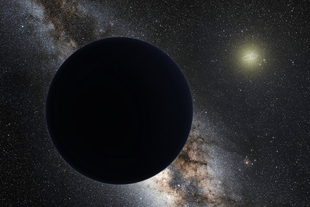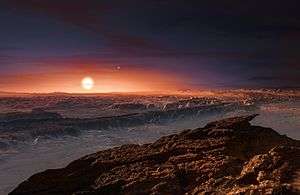Crater 2 dwarf galaxy
| Crater 2 | |
|---|---|
| Observation data (J2000.0 epoch) | |
| Constellation | Crater[1] |
| Right ascension |
11h 49m 14.400s 177.310°±0.03°[1] |
| Declination |
−18° 24′ 46.80″ −18.413°±0.03°[1] |
| Distance | 383,000 ly (117.5 kpc)[1] |
| Apparent magnitude (V) | 20.35±0.02 mag[1] |
| Absolute magnitude (V) | −8.2±0.1 mag[1] |
| Characteristics | |
| Type | dSph[1] |
| Apparent size (V) |
62.4′ (rh=31.2′ ± 2.5′)[1] 6,950 ly (2,132 pc) rh=1066pc ± 84pc[1] |
| Notable features |
4th largest satellite galaxy to Milky Way[1] |
Crater 2 is a dwarf galaxy discovered orbiting the Milky Way,[1] located approximately 380,000 ly from Earth.[2] Crater 2 was identified in imaging data from the VST ATLAS survey.[2]
The galaxy has a half-light radius of ∼1100 pc, making it the fourth largest satellite of the Milky Way.[1] It has an angular size about double of that of the moon.[2][3]
See also
References
- 1 2 3 4 5 6 7 8 9 10 11 12 Torrealba, G.; Koposov, S. E.; Belokurov, V.; Irwin, M. (2016). "The feeble giant. Discovery of a large and diffuse Milky Way dwarf galaxy in the constellation of Crater". Monthly Notices of the Royal Astronomical Society. 459 (3): 2370–2378. arXiv:1601.07178
 [astro-ph.GA]. doi:10.1093/mnras/stw733.
[astro-ph.GA]. doi:10.1093/mnras/stw733. - 1 2 3 Croswell, K. (14 April 2016). "Never-before-seen galaxy spotted orbiting the Milky Way". New Scientist. Retrieved 14 April 2016.
- ↑ "Elusive Dwarf Galaxy Found Orbiting Our Milky Way". Huffington Post. Retrieved 2016-04-19.
External links
This article is issued from Wikipedia - version of the 6/25/2016. The text is available under the Creative Commons Attribution/Share Alike but additional terms may apply for the media files.

.jpg)

